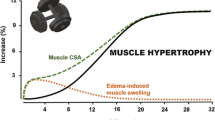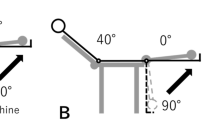Abstract
Maximal active force of skeletal muscle contraction occurs at a sarcomere length where overlap of thick and thin filaments is optimal. However, the interaction of muscle length and active force is complicated. Active force, is the force generated by energy-requiring processes. To calculate active force, passive force provided by in-parallel structures must be subtracted from total force. Sarcomere length will change during a contraction with constant muscle–tendon length, due to tendon stretch. Passive force therefore changes during the contraction. Taking this into account, it has been demonstrated that there is less length dependence of fatigue than previously thought. The remaining difference may be associated with length dependence of activation, a property that is evident with submaximal activation. The sarcomere length at which peak contraction occurs is longer than the length that gives optimal overlap of the filaments and this shift of optimal length appears to be due to increased Ca2+ sensitivity. The increased Ca2+ sensitivity occurs because at longer lengths, the myofilaments are closer together allowing greater force than expected. However, the potential for length-dependent activation has been challenged. Submaximal contractions obtained by recruitment of fewer motor units but with maximal stimulation across different muscle lengths still demonstrate length-dependent activation. In contrast, contractions with similar absolute electromyographic signal magnitude at different lengths do not demonstrate length-dependent activation. Recent work has improved our understanding of how sarcomere length impacts the force of contraction but also reveals inadequacies in our knowledge that need to be addressed by additional research.




Source: MacNaughton et al. 2007 with permission of the author. Muscle length is presented as mm difference from the original optimal length determined with double pulse stimulation at high frequency. Optimal length for 50 Hz contractions occurs at a length longer than the optimum for double-pulse stimulation at 200 Hz

Source: MacNaughton et al. 2007 with permission of the author


Source: MacNaughton et al. 2007 with permission of the author. (Color figure online)
Similar content being viewed by others
Abbreviations
- %:
-
Percent
- Ca2+ :
-
Calcium ion
- mM:
-
Millimolar (millimoles per liter)
- Nm:
-
Nanometer
- µm:
-
Micrometer
References
Abbott BC, Aubert XM (1952) The force exerted by active striated muscle during and after change of length. J Physiol 117:77–86
Allinger TL, Epstein M, Herzog W (1996) Stability of muscle fibers on the descending limb of the force–length relation. A theoretical consideration. J Biomech 29:627–633
Arampatzis A, Mademli L, De Monte G, Walsh M (2007) Changes in fascicle length from rest to maximal voluntary contraction affect the assessment of voluntary activation. J Biomech 40(14):3193–3200
Azizi E, Roberts TJ (2010) Muscle performance during frog jumping: influence of elasticity on muscle operating lengths. Proc R Soc B Biol Sci 277(1687):1523–1530. doi:10.1098/rspb.2009.2051
Bagni MA, Cecchi G, Colomo F (1990) Myofilament spacing and force generation in intact frog muscle fibres. J Physiol 430:61–75
Blix M (1891) Die lange und die spannung des muskels. Skandinavische Archiv fur Physiologie 3 295–318
Blix M (1892) Die lange und die spannung des muskels. Skandinavische Archiv fur Physiologie 4:10
Blix M (1894) Die lange und die spannung des muskels. Skandinavische Archiv fur Physiologie 5:57
Bobbert MF, Ettema GC, Huijing PA (1990) The force–length relationship of a muscle-tendon complex: experimental results and model calculations. Eur J Appl Physiol Occup Physiol 61(3–4):323–329
Brown IE, Cheng EJ, Loeb GE (1999) Measured and modeled properties of mammalian skeletal muscle. II. The effects of stimulus frequency on force–length and force–velocity relationships. J Muscle Res Cell Motil 20(7):627–643
Bullimore SR, Leonard TR, Rassier DE, Herzog W (2007) History-dependence of isometric muscle force: effect of prior stretch or shortening amplitude. J Biomech 40(7):1518–1524
Edman KAP, Kiessling A (1971) The time course of the active state in relation to sarcomere length and movement studied in single skeletal muscle fibres of the frog. Acta Physiol Scand 81:182–196
Fletcher JR, Esau SP, MacIntosh BR (2010) Changes in tendon stiffness and running economy in highly trained distance runners. Eur J Appl Physiol 110:1037–1046
Fontana HdB, Herzog W (2016) Vastus lateralis maximum force-generating potential occurs at optimal fascicle length regardless of activation level. Eur J Appl Physiol 116:1267–1277. doi:10.1007/s00421-016-3381-3
Gerritsen KGM, van den Bogert AJ, Hulliger M, Zernicke RF (1998) Intrinsic muscle properties facilitate locomotor control—a computer simulation study. Motor Control 2(3):206
Gordon AM, Huxley AF, Julian FJ (1966) The variation in isometric tension with sarcomere length in vertebrate muscle fibres. J Physiol 184(1):170–192
Grange RW, Vandenboom R, Houston ME (1993) Physiological significance of myosin phosphorylation in skeletal muscle. Can J Appl Physiol 18(3):229–242
Herzog W, Guimaraes AC, Anton MG, Carter-Erdman KA (1991) Moment-length relations of rectus femoris muscles of speed skaters/cyclists and runners. Med Sci Sports Exerc 23(11):1289–1296
Herzog W, Abrahamse SK, ter Keurs HEDJ (1990) Theoretical determination of force-length relations of intact human skeletal muscles using the cross-bridge model. Pflugers Archiv 416(1-2):113-119
Herzog W, Kamal S, Clarke HD (1992) Myofilament lengths of cat skeletal muscle: theoretical considerations and functional implications. J Biomech 25:945–948
Hill AV (1953) The mechanics of active muscle. Proc R Soc Lond Ser B Biol Sci 141:104–117
Holt NC, Azizi E (2014) What drives activation-dependent shifts in the force–length relationship. Biol Lett 10:4. doi:10.1098/rsbl.2014.0651
Huxley AF (1957) Muscle structure and theories of contraction. Prog Biophys Biophys Chem 7:255–318
Ichinose Y, Kawakami Y, Ito M, Fukunaga T (1997) Estimation of active force–length characteristics of human vastus lateralis muscle. Acta Anat 159(0001–5180):78–83
Jewell BR, Wilkie DR (1958) An analysis of the mechanical components in frog’s striated muscle. J Physiol 143:515–540
Kawakami Y, Fukunaga T (2006) New insights into in vivo human skeletal muscle function. Exerc Sport Sci Rev 34(1):16–21
Labeit D, Watanabe K, Witt C, Fujita H, Wu Y, Lahmers S, Funck T, Labeit S, Granzier H (2003) Calcium-dependent molecular spring elements in the giant protein titin. Proc Natl Acad Sci 100(23):13716–13721
Levin A, Wyman J (1927) The viscous elastic properties of muscle. Proc R Soc Lond Ser B Biol Sci 101:218–243
Levine RJC, Kensler RW, Yang ZH, Stull JT, Sweeney HL (1996) Myosin light chain phosphorylation affects the structure of rabbit skeletal muscle thick filaments. Biophys J 71:898–907
Lieber RL, Loren GJ, Friden J (1994) In vivo measurement of human wrist extensor muscle sarcomere length changes. J Neurophysiol 71:874–881
Lieber RL, Ponten E, Burkholder TJ, Friden J (1996) Sarcomere length changes after flexor carpi ulnaris to extensor digitorum communis tendon transfer. J Hand Surg [Am] 21A:612–618
MacIntosh BR (2003) Role of calcium sensitivity modulation in skeletal muscle performance. News Physiol Sci 18:222–225
MacIntosh BR, Bryan SN (2002) Potentiation of shortening and velocity of shortening during repeated isotonic tetanic contractions. Pflügers Archiv 443:804–812
MacIntosh BR, MacNaughton MB (2005) The length dependence of muscle active force: considerations for parallel elastic properties. J Appl Physiol 98(5):1666–1673
MacIntosh BR, Rassier DE (2002) What is fatigue? Can J Appl Physiol 27(1):42–55
MacNaughton MB, MacIntosh BR (2006) Reports of the length dependence of fatigue are greatly exaggerated. J Appl Physiol 101:23–29
MacNaughton MB, Campbell JJ, MacIntosh BR (2007) Dantrolene, like fatigue, has a length-dependent effect on submaximal force–length relationships of rat gastrocnemius muscle. Acta Physiol (Oxf) 189(3):271–278
Maganaris CN (2001) Force–length characteristics of in vivo human skeletal muscle. Acta Physiol Scand 172(4):279–285
Maganaris CN (2003) Force–length characteristics of the in vivo human gastrocnemius muscle. Clin Anat 16(3):215–223
Martyn DA, Gordon AM (1988) Length and myofilament spacing-dependent changes in calcium sensitivity of skeletal fibres: effects of pH and ionic strength. J Muscle Res Cell Motil 9(5):428–445
Rack PMH, Westbury DR (1969) The effects of length and stimulus rate on tension in the isometric cat soleus muscle. J Physiol 204(2):443–460
Ramsey RW, Street SF (1940) The isometric length-tension diagram of isolated skeletal muscle fibers of the frog. J Cell Comp Physiol 15(1):11–34. doi:10.1002/jcp.1030150103
Rassier DE, MacIntosh BR (2002) Length-dependent twitch contractile characteristics of skeletal muscle. Can J Physiol Pharmacol 80(10):993–1000. doi:10.1139/Y02-127
Rassier DE, Tubman LA, MacIntosh BR (1997) Length-dependent potentiation and myosin light chain phosphorylation in rat gastrocnemius muscle. Am J Physiol Cell Physiol 273(1 Pt 1):C198–C204
Rassier DE, MacIntosh BR, Herzog W (1999) Length dependence of active force production in skeletal muscle. J Appl Physiol 86(5):1445–1457
Scott SH, Brown IE, Loeb GE (1996) Mechanics of feline soleus: I. Effect of fascicle length and velocity on force output. J Muscle Res Cell Motil 17(2):207–219. doi:10.1007/BF00124243
Spector SA, Simard CP, Fournier M, Sternlicht E, Edgerton VR (1982) Architectural alterations of rat hind-limb skeletal muscles immobilized at different lengths. Exp Neurol 76(1):94–110. doi:10.1016/0014-4886(82)90104-2
Stephenson DG, Williams DA (1982) Effects of sarcomere length on the force–pCa relation in fast- and slow-twitch skinned muscle fibres from the rat. J Physiol 333:637–653
ter Keurs HEDJ, Iwazumi T, Pollack GH (1978) The sarcomere length-tension relation in skeletal muscle. J Gen Physiol 72:565–592
ter Keurs HEDJ, Rijnsburger WH, van Heuningen R, Nagelsmit MJ (1980) Tension development and sarcomere length in rat cardiac trabeculae: evidence of length-dependent activation. Circ Res 46:703–714
Walker SM, Schrodt GR (1974) I segment lengths and thin filament periods in skeletal muscle fibers of the rhesus monkey and the human. Anat Rec 178(1):63-81
Wakahara T, Kanehisa H, Kawakami Y, Fukunaga T (2007) Fascicle behavior of medial gastrocnemius muscle in extended and flexed knee positions. J Biomech 40(10):2291–2298. doi:10.1016/j.jbiomech.2006.10.006
Yang Z, Stull JT, Levine RJ, Sweeney HL (1998) Changes in interfilament spacing mimic the effects of myosin regulatory light chain phosphorylation in rabbit psoas fibers. J Struct Biol 122:139–148
Author information
Authors and Affiliations
Corresponding author
Additional information
Communicated by Nigel A. S. Taylor.
Rights and permissions
About this article
Cite this article
MacIntosh, B.R. Recent developments in understanding the length dependence of contractile response of skeletal muscle. Eur J Appl Physiol 117, 1059–1071 (2017). https://doi.org/10.1007/s00421-017-3591-3
Received:
Accepted:
Published:
Issue Date:
DOI: https://doi.org/10.1007/s00421-017-3591-3




